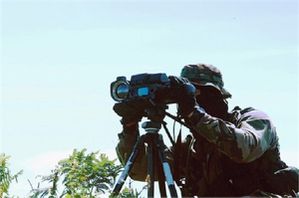10 September 2013 Thales UK
Thales UK today launched a new lightweight multifunction surveillance and target locator system, SOPHIE Lite. Weighing in at class-leading, fully-operational weight of only 1.6kg, SOPHIE Lite can be deployed in a variety of operational scenarios by both military and civil users.
The new ultra-compact system has a fully-integrated suite of sensors, including an uncooled thermal imager, TV/Near Infra-Red (NIR) sensor, high-performance eyesafe laser rangefinder, digital compass and GPS. Operational roles for SOPHIE Lite include force protection, forward observation, forward air control, covert surveillance, asset protection and homeland security.
SOPHIE Lite is the latest addition to Thales’s family of combat-proven SOPHIE cameras, which collectively offer the widest range of capabilities to meet any operational requirement for hand-held surveillance and targeting. Thousands of Sophie cameras are in operation with armed forces, including the British Army, and security teams around the world.
“Since the launch of SOPHIE UF in 2009, Thales has worked continually to evolve the product in line with customer needs, reducing the weight from 3.5kg then to 1.6kg today,” said Gil Michielin, Vice President of Thales’s optronics business.
"To reduce the weight by nearly 2kg, without compromising even 1 per cent of the performance, is a significant achievement and of enormous value to the soldiers and security personnel who carry the camera as part of their standard kit.
“SOPHIE Lite is light, small and affordable. Switching from standard optical to digital technologies has reduced the weight and enhanced the image delivered to the user. We believe that the combination of functionality and specification will extend the appeal of SOPHIE Lite to a broader user base, including security teams and mobile perimeter guards; SOPHIE Lite is small enough to fit in the glove compartment of even a standard saloon car, for instance.
“This is an exciting evolution of our popular SOPHIE offering. We have paid serious attention to feedback from our customers, and indeed potential customers, to ensure that SOPHIE Lite hits the mark with its performance, functionality and ease of use.”
commenter cet article …









